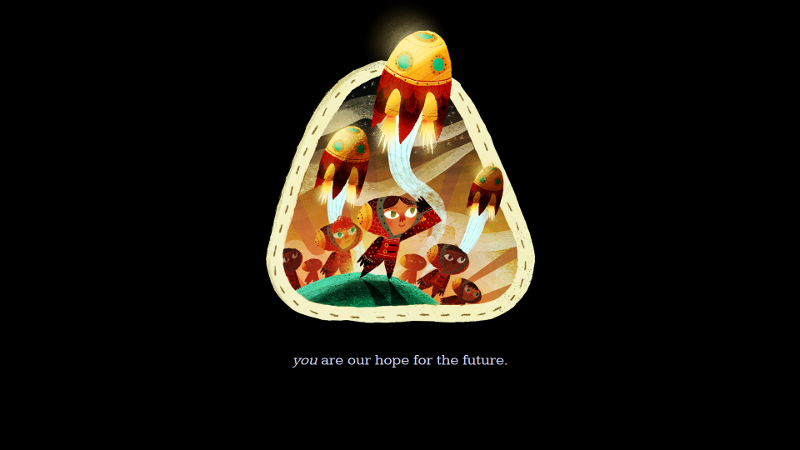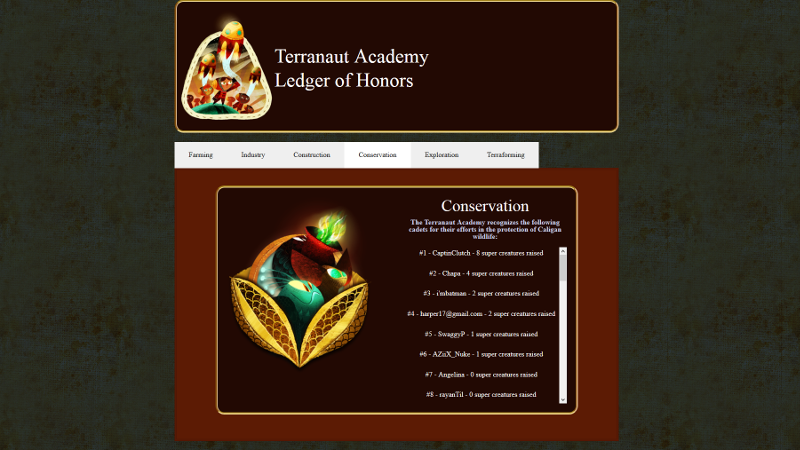Terra
With Funomena / UC Davis
January 2014 to July 2015

What platform is it on? Can I play?
Terra is a desktop browser game, so it’s playable on any computer with Firefox, Chrome, or Internet Explorer. Unfortunately, the servers shut down after the last classroom test, so you can’t play.
What’s it for? Who’s it for?
Terra was designed to encourage people to exercise. Cynthia Carter Ching and her team from the UC Davis School of Education contracted the development of Terra out to Funomena, which is where I helped build it. Terra was a part of an experimental middle school health program that helped kids take charge of their own health through exercise and healthy eating.

How do I play?
Each classroom that played Terra played as a team of explorers trying to settle and terraform the mysterious planet Caligo after an ecological crisis made the Earth uninhabitable. Players worked to expand their colony using energy generated from their Fitbit pedometers. The more players walked, the more actions they had available to them in the game. Energy could be expended to build structures, search for native Caligan life, and thwart disasters that threatened the players’ colonies.
Each game of Terra took place over the course of several months. As players explored and terraformed the planet, they generated a collective resource called “atmos”. Each class worked together to generate a certain amount of atmos by the end of the game. If they reached this milestone, the entire class won the game, and a pizza party at the end of the game. Players who did particularly well also received individual prizes for Most Area Explored, Most Buildings Constructed, and other superlatives.

Who else worked on the game?
Robin Hunicke and Martin Middleton developed the initial design of Terra in 2013. In my time on the project, I worked closely with artist Glenn Hernandez to develop the new disaster mechanic and new buildings for the players to build. I also consulted with Robin and the team from UC Davis to make sure the game stayed true to its original vision and goals.
What did you do?
My first project in Terra involved adapting the successful single-player prototype to a 30-player classroom environment. When I started on the project, the team had just finished testing a version of the game where each player played on their own plot of land, and had no interaction with any other player outside of the collective atmos goal. Robin and the UC Davis team wanted to make the game feel like more of a collaborative experience between all the players. To this end, I reimplemented the game in a real-time multiplayer engine. I believed that when players could see others interacting with the world, they would understand that their actions mattered as well. Most of the time, students would be playing the game in the classroom, so they were very likely to see their friends exploring and building.
I also was responsible for developing the “disaster” mechanic. Over time, disasters would threaten players and their colonies. Once they were notified of an impending disaster, players had several game days to thwart the disaster, either by building defensive structures or sacrificing resources. The primary goal of the disaster mechanic was to reinforce the importance of Fitbit usage and exercise. In order to give the player a strong sense that the input from their Fitbit mattered, the resource system of the game had been set up as a positive feedback loop, which was augmented by input from the Fitbit. I designed and tuned the disasters to act as something of a high-pass filter on that resource system; since preventing disasters required large amounts of resources, only players who had put in some effort could prevent the disaster. Those who hadn’t received a punishment that set them back significantly from their peers. At the end of the game, players who hadn’t exercised were very clearly less successful than players who had.

Once the game relaunched in its new multiplayer format, I also visited a pilot middle school classroom in Davis, CA to take notes and get feedback from the students. I made several modifications to the core game system based on information I gathered. For example, students in the first cohort of players discovered and exploited an overlooked feedback loop in the games resource system. Those students figured out that the Foundry building in the game could improve the output of Ore from Mines, which could then be turned into more Foundries. To fix this, I changed the Foundries to only improve mining operations in their immediate vicinity, effectively limiting their benefit. The second cohort of students placed significantly fewer Foundries, and their success with gathering Ore was significantly more stratified.
What happened to the game?
Development on Terra ended in mid-2015. Dr. Ching and her team are currently working on a paper about the effectiveness of the game based on data gathered in the second year of testing.

Let me know what you think of this article on twitter @tedw4rd or leave a comment below!